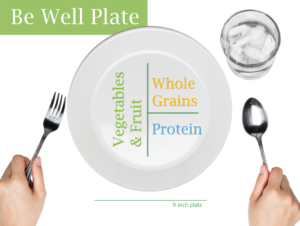If you’re one of the 97+ million U.S. viewers of NCAA’s March Madness, you’re bound to be tempted by typical gameday snacks. Wing orders alone increase by 24% during the tournament, and if your favorite team loses, you’re more likely to indulge in a variety of gameday treats. Pizza and dessert orders also increase by 19% and 9%, respectively, following losses versus wins. But what about the beer? Three and a half million extra cases of it are produced in March to keep up with demand.
It’s already easy to overeat traditional gameday foods (pizza, wings, chips, dips, and desserts) that are notoriously high in salt, sugar, and fat. It’s a combination that fires-up our brain’s reward center and steers us towards overeating and unintended weight gain. Add distracted eating to the mix during March Madness, and you’re even more likely to consume more than intended.
Keep your health top of mind through March and enjoy gameday snacks in moderation by following these mindful, balanced-eating tips:
If you attend a viewing party…
Enjoy your game day snacks in moderation! But keep a balanced plate in mind as you munch through the playoffs. Remember, a balanced plate includes half vegetables and fruit (the veggie tray is your game day BFF), a quarter whole grains, and a quarter protein. Although it’s more likely you’ll graze rather than serve yourself all at once, aim to make food choices that would fit nicely into this template (1/2 of what you eat should be vegetables/fruits, 1/4 protein, 1/4 whole grains). Even better, stick to small, appetizer-sized plates to automatically control how much food you can portion yourself.
Arrive at the viewing party with the intention to choose primarily plant-based, fiber-rich snack foods (i.e. fruits, vegetables, and whole grains). Try to use the viewing party as an opportunity to hit your daily fiber goal (25 grams for women, 38 grams for men). Besides supporting gut health and controlling blood sugar, getting adequate fiber can help tame hunger, reducing the risk of overeating all the tempting treats before half-time even hits.
You’re also better off socializing somewhere other than the snack table. Although you’d be conveniently located near the veggie platter, hanging out by the food may lead to mindless munching between conversations.
Maybe you’re at a sports bar and there’s no nutritious food in sight. What should you do? Try ordering a large glass of water before your food arrives. Aim to drink about 16 ounces (two cups) before snacking commences. Water can help increase the volume in your stomach, so you feel fuller after smaller portions of pizza, wings, and fried food. Ask for a veggie plate! Stick to alcoholic drinks in moderation (one for women, two for men) and switch to water or unsweetened club soda or seltzer afterward.
If you were asked to bring snacks to share, check out our list of nutritious, fiber-rich gameday foods below to provide yourself and others with balanced options at any viewing party you attend.
If you host a viewing party…
Try to provide a balanced spread of delicious game day snacks that will leave everyone feeling satisfied. Make half the offerings fruits and vegetables, a quarter grains, and a quarter protein.
Ask guests to assist you in your pursuit of a healthier March Madness by suggesting they bring foods or recipes that highlight vegetables, whole grains or beans/legumes.
Offer appetizer-sized plates to help guests control portion size and reduce food waste. If you’re providing alcoholic or sugar-sweetened beverages, offer small, 8-ounce cups for the same reason.
Provide space to socialize away from the food table, if possible. Have a space for board games, playing cards or other alternative activities to eating in-view of the game. Commit food to just the kitchen or dining room rather than spreading it throughout the living areas.
Practice safe food-handling techniques to reduce the risk of bacterial contamination and foodborne illness. Most importantly, wash your hands thoroughly with warm soapy water before handling food. Keep hot food hot (above 140 degrees) using chafing dishes, slow cookers, and warming trays. Keep cold food cold (below 40 degrees) using small service trays or by nesting serving dishes in ice. Food that isn’t being actively warmed or cooled can sit-out at room temperature for up to two hours before needing to be stored away in the refrigerator, but only if you plan on eating it in the future. Leftovers are safe for up to four days in the refrigerator, and always reheat them to an internal temperature of at least 165 degrees. Food can sit out at room temperature for up to four hours if you don’t plan on saving it for leftovers. After four hours at room temperature, toss any remaining food.
Need fresh snack ideas to get started? Check out these healthier versions of your favorite game day snack foods:



Leave A Comment
You must be logged in to post a comment.